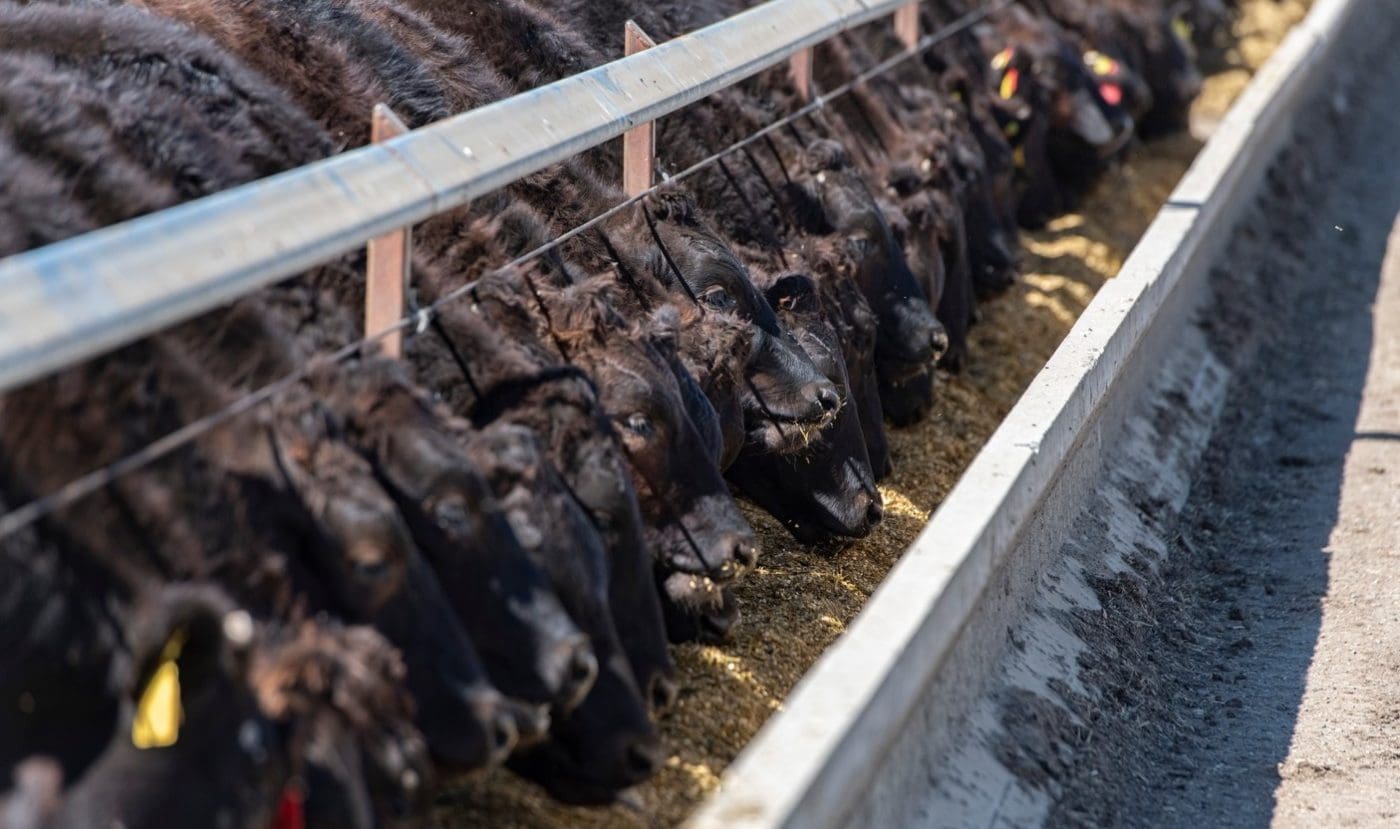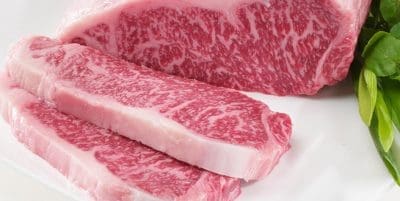
IN A segment that has been notoriously volatile over the past five or six years, Australian Wagyu feeder prices have been remarkably stable since the back end of last year.
Good quality Wagyu F1 feeder steers out of solid Angus maternal lines are currently selling in a band between about 410c/kg and 450-460c/kg, a sample of seven large supply chains have told Beef Central this week.
A figure around 430c/kg seems the mid-point this week, with the best of that money for ‘known performers’ with good production history. F1 feeders of less desirable genetics, without known performance might be at 400c, a large supply chain manager said.
Those prices have not changed much since November, following the normal seasonal ‘spike’ around August-September last year, when good Wagyu feeders peaked at about 470-480c/kg, before then starting to ease. This time last year, F1s were making anywhere from 405-430c/kg.
For higher content F4/Purebred cattle – the bulk of which are bred in Queensland – we’ve seen quotes this week of 500-540c/kg liveweight for feeders. Fullblood prices are largely dependant on prior history, making them hard to price in a report like this.
Greater supply of higher content Wagyu feeders has seen the F4-Purebred premium decline over F1 prices. Where once it was typically 100-120c/kg, for some programs the premium is now “well under a dollar”, several chains said.
Wagyu premium over Angus
What’s disappeared for the time being is any great premium for Wagyu F1s over Angus.
Beef Central’s fortnightly feeder steer update last week had Angus heavy feeders at 390-410c/kg, depending on location. The premium for Angus over flatbacks has grown to 30c/kg this month, after virtually disappearing late last year as markets were flooded with southern feeder cattle under seasonal pressure.
That suggests the old metric of an F1/Angus premium closer to a dollar a kilo is gone, for the time being at least.
“Some vendors thought that when the Angus price kicked back there in February that Wagyu F1s should follow them up. But they are two very different markets,” one large Queensland supply chain manager said.
What’s evident at present is that Wagyu F1 feeders are reasonably plentiful, but with most feedlots already close to full, there’s no great appetite to bid-up to place even more on feed.
In fact the opposite may be the case. National feedlot utilisation at the end of December was at 87.5pc, with 90pc seen as a practical industry operating limit, due to pen cleaning, maintenance, seasonality in some states, and other factors.
 So what happens if a big surplus of Wagyu feeders again emerges this year?
So what happens if a big surplus of Wagyu feeders again emerges this year?
Beef Central was told that given current prices, one of the ‘majors’ was already feeding a few cheaper Wagyu F1s on a shorter-fed 160-200 day program, using more conventional ration. That beef could not enter an ‘Angus’ brand program, despite the fact it might have significant marbling. The best it could hope for might be a brand program built on a ‘certain level of marbling,’ Beef Central was told.
One Wagyu feedlot manager said most committed Wagyu F1 breeders remain firmly engaged with long-term supply arrangements with lotfeeders, with relatively few cattle left looking for a home.
“There’s a few floaters out there, but generally they are longer-term suppliers,” he said. “Others that have only gotten into Wagyu over the past few years are trying to find homes, but it isn’t that easy,” one supply chain manager said.
“But whether there is an over-supply this year, it’s still too early to tell,” he said.
Another large NSW supply chain manager said his business had received “a lot of calls from people” over F1 supply recently.
“But quite frankly, because we’re not looking to grow any more beyond what we take from our current producer group, we’re not looking to go outside that – particularly without any prior performance record.”
“There’s pretty strong signals from the Wagyu brand owners over production volumes around current levels, and no more. That’s why Wagyu feeder prices have probably been more stable than they have for some considerable time.”
Another Queensland Wagyu supply chain manager told Beef Central that based on phone calls he’d received from breeders over the past few months, he could have placed another 20,000 F1s head on feed – except that his yard was already full.
“I can’t even find any custom-feeding space to try to place those cattle, even if I wanted to. At the moment, everywhere is chock-a-block.”
Small check in Wagyu numbers on feed?
Recent statistics presented in ALFA/MLA’s quarterly feedlot surveys shed some light on the extent of Wagyu feeding in Australia.
The survey includes cattle numbers segmented into ‘days on feed’ categories, the highest of which is ‘+300-days.’ If it is accepted that there are very few, if any Angus now involved in 300-day programs (270 days is now about the limit), any cattle on feed in the +300-days category must be Wagyu.
Quarterly surveys last year reported about 300,000 cattle on feed in the 300-days-plus category, but there’s some evidence that that number may now be moderating.
Several large commercial yards in Queensland and NSW have confirmed that they are winding-back Wagyu numbers a little, replacing them with Angus or even flatback shortfeds as pens close out.
How far that trend goes is unclear, but the reasons appear to be about hedging against the possibility of challenging Wagyu meat trading conditions going forward a year from now, when current Wagyu intakes close-out – at a time when everyday chilled grainfed cuts in export markets like the US (as well as other markets where US exports will be limited) are likely to be in high demand for the next year or two.
“The risk profile is probably why some grainfeeders are realigning their business a little. Some got badly burned in the last Wagyu down-cycle. It’s hard to speculate about where Wagyu beef prices will be in 15 or 16 months time, when current entry feeders are being sold as boxed meat.”
Relative returns
Another lotfeeder with a large Wagyu program explained to Beef Central that he uses a metric based on profitability per pen over a period of time.
The basic question his comments raised was: Is a lotfeeder better off financially with three cycles of 120-day cattle, or a single cycle of longfed Wagyu over the next 12 months?
“Lotfeeders always have to normalise their return on a pen basis by month, or at least annually,” he said. “You might make $200 a head feeding a Wagyu steer for the next year, but across the same period, if you can net $100 a head feeding three cycles of Angus, you’re in front.”
‘For some, that would be somewhat attractive, but some lotfeeders do not annualise their pen returns very well,” he said.
Rising tide floats all boats?
Episode3 analyst Matt Dalgleish is looking at Wagyu developments this week, in advance of the Australian Wagyu Association Conference in Perth next month.
He made the point that ‘a rising tide floats all boats’ in a high export beef demand year like 2025.
“That has to support Wagyu, along with every other segment of the beef industry,” he said.
“But sticking with the nautical analogy, the Wagyu boat is currently pretty well supplied, so it may sit a little lower in the water than it would normally expect.”
“I wouldn’t call it as a massive glut of Wagyu feeders this year – as has been seen in several episodes in the past – but there’s acknowledgement that there’s a lot of feeders around.”
Mr Dalgleish said if it was accepted that there was somewhere around 300,000 Wagyu on feed last year, each fed for roughly 12 months, that represented around 10pc of Australia’s 3.1 million head of grainfed cattle exiting feedlots last year.
“But they are taking three times or more of the turnover of conventional shortfed cattle,” he said.
After the boom-bust cycles seen in Wagyu over the past ten years, the industry appeared to be getting better at managing that cycle, and trying to manage supply a little better, given Wagyu’s very long production cycles, Mr Dalgleish said.
“Having said that, the positives in terms of demand and the growth cycles are still there for Wagyu.”
US Wagyu growth
Another factor the Australian Wagyu industry has to take into consideration is the recent growth in the US Wagyu beef industry.
Where once product from Australia was the only real alternative to Japanese-produced Wagyu beef in world markets, the US industry has grown rapidly over the past three or four years. Some of that production – largely built on high-quality Australian Wagyu genetics – will inevitably end up in export markets, competiting head-to-head with Australian Wagyu brands.
On top of that, big advances in marbling are being seen in conventional US beef production. The percentage of US beef carcases now graded USDA Prime (roughly marbling score four or higher) or Choice (scores +2-3) last year sat at 83pc. Go back to the early 2000s and that figure was around 55pc, meaning there is a lot more marbled beef in the US system.
“US consumers rate marbling highly when choosing meat to purchase, and ‘brand Wagyu’ is now starting to get a bigger footprint in the US beef market,” Mr Dalgleish said.
“So as the US beef industry produces more Wagyu, equally, demand for highly marbled product in the market is growing,” he said.
“Australian Wagyu could still benefit in the US, if the US consumer demand grows in parallel with domestic US Wagyu production.”
Wagyu meat sales look promising
Barring ration prices shooting up $50-$80/tonne, current demand and price outlook for Wagyu beef in international markets looks ‘reasonably stable to strong,’ several large supply chain managers said.
“No customers are saying they want to increase volume this year, but at current intake price levels, it looks reasonably stable. But there is certainly little international appetite to pay more for good quality Australian Wagyu beef,” he said.
Another brand manager said there had been some evidence of trading-down in some international markets, for financial and cost-of-living reasons.
“In some cases, customers that chased Wagyu marbling score 8-9s are now looking at 6-7s, and those that bought 6-7s are now looking for 5-6s,” he said.
“And the problem in a market like China is that they don’t want loin cuts. They are happy to take forequarter meat, but want to pay us Angus prices for Wagyu loins. China is pushing back on price – not only on Wagyu, but all categories.”
“There’s still pressure on that premium end of the beef market, despite what’s going on in the US in terms of supply shortage. Consumers are looking for value, and there’s different ways of doing that – and accepting a lower marbling score is just one of those.
“But the challenge with that is that if everyone wants a marbling score 5-7, it dilutes the potential for premiums at the top end. You still have to get the revenue, across the marbling spectrum, to make the sums work.”
Another large Wagyu stakeholder just back from the enormous Dubai GulfFood trade show event said he still saw very strong demand for Wagyu, especially from across the Middle East, North Africa and Europe.
“Apart from the Chinese, who still place a lot of priority on the upper marbling ranges, the sweet spot at present is that marbling score 5-7 product,” he said.
“The demand at present is very positive. We’ve forward sold all of our production for the next three months – but that’s mostly to existing customers.”
- The Australian Wagyu Association’s Wagyu Edge Conference takes place in Perth from 9-11 April.
